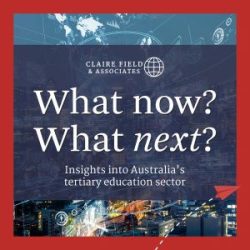New research from IDP Education has revealed that career development opportunities are now the most important factor for international students when choosing where to study, a finding with significant implications for Australia as it looks to maintain its competitive edge in global education.
The Emerging Futures 7 – Voice of the International Student survey, conducted in March 2025, collected responses from more than 6,000 students across 100 countries. The study found a clear shift in student priorities, with graduate employment prospects now seen as the strongest indicator of a high-quality education — even ahead of university rankings, campus facilities, and the quality of academic staff.
According to the research, 58 per cent of international students identified ‘job outcomes from the institution’ as the top non-academic factor influencing their choice of study destination.
Simon Emmett, Chief Partner Officer at IDP Education, said the findings highlight the critical role international students play in addressing future workforce needs in Australia.
“We know that international students are increasingly selecting study destinations that help them become job ready, with access to post-study work opportunities being a major influence,” Mr Emmett said.
He also noted the dual benefit for host countries, explaining, “International students are helping to fill essential skill shortages while also forging enduring diplomatic links between their home and host nations.”
The research comes at a pivotal time, with Australia heading towards a federal election. Emmett stressed that governments and policymakers must recognise the importance of creating supportive pathways for international students to transition from education into the workforce.
Despite generally positive sentiments towards studying in Australia, the research also pointed to growing concerns around financial pressures. Rising tuition fees, living costs, and high visa savings requirements are causing many students to reconsider their options. Half of those surveyed said they would consider switching to a different destination country if lower financial barriers were offered.
“Two-thirds of students told us that tuition fees, living costs, and additional expenses are their biggest concerns,” Mr Emmett said. “Financial accessibility will be crucial to maintaining Australia’s appeal to international students.”
Nonetheless, Australia remains the top study destination for international students, ahead of the USA, UK, and Canada. Australia has seen a five percentage point increase in student preference since March 2024, while Canada has experienced a six percentage point decline over the same period.
For former international student Sunny Singh, now an engineer working in Geelong, Victoria, the opportunity to study and work in Australia has been life-changing. Singh said international students like himself are helping to close critical skills gaps in sectors under pressure.
“International students come to Australia with big ambitions. We are investing in our futures and want to contribute to the places where we study and work,” Mr Singh said.
“I’m proud of the career I’ve built. It’s rewarding to know that my work in engineering is helping address a sector in real need,” he added.
The Emerging Futures 7 report offers valuable insights for governments, institutions, and employers as they plan for Australia’s future workforce needs.
More information about the research is available at https://partners.idp.com/emergingfutures.
















